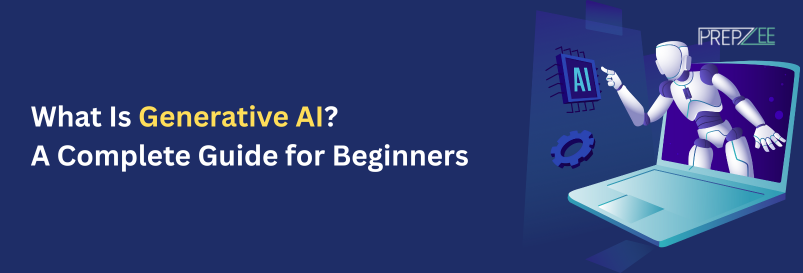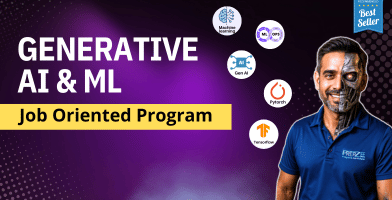What Is Generative AI? A Complete Guide for Beginners in 2025


Table of content
The world of Artificial Intelligence (AI) is rapidly evolving, and one of the most exciting and transformative areas is Generative AI. By 2025, Generative AI has moved from the realm of research labs into everyday applications, influencing everything from art and entertainment to business and science. This comprehensive guide is designed for beginners who want to understand what is Generative AI, why it’s so prevalent, and how they can start their journey into this fascinating field. If you’re wondering how can I learn artificial intelligence and specifically Generative AI, you’ve come to the right place. This article will break down the concepts in simple terms and provide insights into the world of learning AI programming. For those seeking structured education, we’ll also touch upon the importance of training and the availability of AI course. Understanding Generative AI is becoming increasingly crucial in 2025, and this guide will provide you with a solid foundation to learn artificial intelligence online.
Why Generative AI Is Everywhere in 2025?

The pervasive presence of Generative AI in 2025 is the result of a confluence of factors. Firstly, significant advancements in deep learning algorithms and neural network architectures have led to the creation of more powerful and sophisticated generative models. These models can now produce remarkably realistic and coherent outputs across various data modalities, including text, images, audio, video, and even code. Secondly, the increasing availability of vast amounts of data, crucial for training these complex models, has played a pivotal role. The more data a Generative AI model is trained on, the better its ability to generate novel and meaningful content. Thirdly, the decreasing cost and increasing accessibility of powerful computing resources, particularly cloud-based GPUs, have made it feasible for a wider range of individuals and organizations to develop and deploy Generative AI applications.
Furthermore, the growing recognition of the immense potential of Generative AI across diverse industries has fueled its widespread adoption. In creative fields, it’s being used to generate art, music, and writing. In business, it’s aiding in content creation, marketing, and product design. In science and technology, it’s being applied to drug discovery, materials science, and synthetic data generation. This broad applicability has made Generative AI a ubiquitous technology in 2025. For those looking to participate in this revolution, AI training and AI course offer pathways to acquire the necessary skills. Understanding why Generative AI is so prevalent is the first step in appreciating the opportunities in artificial intelligence. Many individuals are now exploring how can I learn artificial intelligence to be part of this transformative wave. The ease of access to resources for programming has also contributed to its widespread adoption.
What is Generative AI?

At its core, Generative AI is a branch of artificial intelligence focused on creating new, original data instances that resemble the data on which the model was trained. Unlike discriminative AI models, which are designed to classify or predict existing data (e.g., identifying whether an image contains a cat or a dog), Generative AI models learn the underlying patterns and structure of the training data and then use this knowledge to generate new, unseen data points. Think of it as an AI that learns the “style” of something – be it a type of painting, a genre of music, or a form of writing – and can then create new examples in that same style.
Generative AI encompasses a variety of techniques and architectures, including Generative Adversarial Networks (GANs), Variational Autoencoders (VAEs), and diffusion models. Each of these approaches has its own strengths and weaknesses and is suited for different types of data generation tasks. Understanding the fundamental principles behind these models is a key aspect of learning AI programming and mastering Generative AI. For beginners wondering how can I learn artificial intelligence, starting with the basic concepts of neural networks and then delving into the specifics of generative models is a recommended approach. Many AI training programs and AI course online options provide a structured introduction to these topics. The ability of AI to create novel data distinguishes it within the broader field of artificial intelligence.
Why Learn Generative AI?

Learning Generative AI in 2025 offers a multitude of compelling reasons. Firstly, it’s a field with immense potential for innovation and creativity. The ability to generate new content programmatically opens up exciting possibilities across various domains, making it a highly sought-after skill in the job market. As artificial intelligence continues to permeate more aspects of our lives, professionals with expertise in Generative AI will be in high demand. Secondly, the field is rapidly evolving, offering continuous learning opportunities and the chance to work on cutting-edge technologies. For those looking for a dynamic and intellectually stimulating career, with a focus on it is an excellent choice.
Furthermore, the skills acquired in learning Generative AI are highly transferable to other areas of AI and machine learning. A solid understanding of neural networks, deep learning, and data modeling, which are fundamental to Generative AI, provides a strong foundation for exploring other AI domains. Numerous training programs and AI course online options cater to individuals looking to specialize in this area. For those wondering how I can learn artificial intelligence and carve out a niche, it presents a promising path. The practical applications of this are expanding rapidly, making it a valuable skill for those seeking career options in artificial intelligence. The resources available to learn artificial intelligence online, including courses specifically on Generative AI, are becoming increasingly comprehensive and accessible.
Differences Between AI, Machine Learning, and Generative AI

To gain a clear understanding of Generative AI, it’s helpful to distinguish it from the broader fields of Artificial Intelligence (AI) and Machine Learning (ML). As mentioned earlier, AI is the overarching concept of machines performing tasks that typically require human intelligence. Machine Learning (ML) is a subset of AI that enables systems to learn from data without explicit programming. Generative AI, in turn, is a specific type of machine learning that focuses on creating new data instances.
Think of it as a hierarchy: AI is the broadest category, encompassing various approaches to making machines intelligent. ML is one of the key methods to achieve AI, involving algorithms that learn from data. It is a specialized area within ML where the goal is to generate new data that resembles the training data. While all Generative AI models utilize machine learning techniques, not all machine learning models are generative. For instance, a model that classifies emails as spam or not spam is a discriminative model, not a generative one. Understanding these distinctions is crucial for anyone embarking on programming. Many introductory AI course online options will cover these fundamental differences. For those asking how can I learn artificial intelligence, grasping this hierarchy provides a clearer roadmap. The specific focus on data creation sets Generative AI apart within the landscape of artificial intelligence.
How Does it Work?

Generative AI models learn the probability distribution of the training data. In simple terms, they try to understand the underlying rules and patterns that govern the data they are trained on. Once trained, they can sample from this learned distribution to create new data points that adhere to these patterns. The specific mechanisms vary depending on the type of generative model:
Generative Adversarial Networks (GANs):
GANs involve two neural networks: a generator and a discriminator. The generator tries to create realistic data samples, while the discriminator tries to distinguish between real data and generated data. These two networks are trained in an adversarial manner, with the generator constantly trying to fool the discriminator, leading to the generation of increasingly realistic outputs.
Variational Autoencoders (VAEs):
VAEs are probabilistic generative models that learn a compressed representation (latent space) of the input data. They consist of an encoder that maps the input data to this latent space and a decoder that reconstructs the data from the latent space. By sampling from the latent space, VAEs can generate new data points.
Diffusion Models:
These models learn to reverse a gradual noising process. They start with random noise and learn to iteratively Denise it in a way that produces realistic data samples. Diffusion models have shown remarkable success in generating high-quality images.
Understanding the architectures and training processes of these models is a more advanced aspect of learning AI programming. However, even beginners can grasp the core idea that Generative AI learns the essence of data and then uses that understanding to create something new. Many intermediate and advanced AI training programs and AI course online options delve into the technical details of these models. For those looking to truly master Generative AI, a solid foundation in the underlying mathematics and computer science, often gained through dedicated programming resources, is essential.
Benefits and Limitations

Generative AI offers a wide array of benefits across various domains:
- Content Creation: It can generate realistic images, compelling text, engaging music, and even synthetic videos, revolutionising creative industries and marketing.
- Data Augmentation: It can create synthetic data that can be used to augment training datasets for other AI models, improving their performance and robustness, especially when real data is scarce.
- Drug Discovery and Materials Science: It can be used to generate novel molecular structures and material designs, accelerating scientific discovery.
- Personalization: It can create personalized content and experiences tailored to individual user preferences.
- Code Generation: Some models can even generate computer code, potentially increasing developer productivity.
However, Generative AI also has limitations:
- Quality and Control: While rapidly improving, the quality of generated content can sometimes be inconsistent, and controlling the specific attributes of the output can be challenging.
- Bias: Generative AI models can inherit and even amplify biases present in their training data, leading to unfair or discriminatory outputs.
- Ethical Concerns: The ability to generate realistic fake content raises significant ethical concerns regarding misinformation, deepfakes, and copyright infringement.
- Computational Cost: Training large Generative AI models can be computationally expensive and require significant resources.
- Understanding and Interpretability: The complex inner workings of many deep Generative AI models can make it difficult to understand why they generate specific outputs.
For those interested in pursuing AI training and working with Generative AI, understanding both its potential and its limitations is crucial. Addressing these limitations is an active area of research and development within the field of artificial intelligence. As you learn artificial intelligence online and delve deeper into learning AI programming, you will gain a more nuanced understanding of these benefits and challenges. The future of Generative AI will depend on our ability to harness its power responsibly while mitigating its potential risks.







